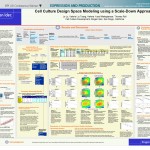
As an industry initiative to “provide assurance of quality,” the ICH Q8 guideline proposes building quality into the design of experiments by defining the process design space within which critical product quality attributes are within an acceptable range. A characterized design space not only enhances process knowledge but also can later be utilized for process validation and regulatory filings, saving on the time and cost of additional filings if process changes are implemented in the future.
Because it is neither possible nor desired to conduct large numbers of experiments at manufacturing scale, a key prerequisite to developing a design space is to qualify a scale-down model that can be used to determine the impact of various process parameters on performance indicators and product quality attributes. The qualified scale-down cell culture model is then applied to parameter screening and modeling design studies to define a multi-dimensional cell culture process model based upon performance and product quality responses. The end result is a mathematically based model of the design space that can be used to define specifications and predict process behaviors based upon the unique characteristics of the process.
Here we outline a systematic approach used to generate the cell culture design space model from parameter screening to model confirmation for a late stage antibody cell culture process. Our strategy uses a step-wise approach to build and evaluate our model. First is the process of identifying parameters based on process knowledge and assessment of process risks, and determining process and product responses to be measured. Second is the screening of process inputs to identify significant parameters that can impact the cell culture process or product. Third, Response Surface Modeling design studies are performed to model the relationships between input parameters and process responses. Based on the performance and product attributes, a preliminary mathematical model of our process is created. Finally, the model is verified for predictability and further augmented to incorporate verification data into the original model to enhance model resolution. A mathematically stronger model results in a well-defined design space which may lead to potential future process improvements.
